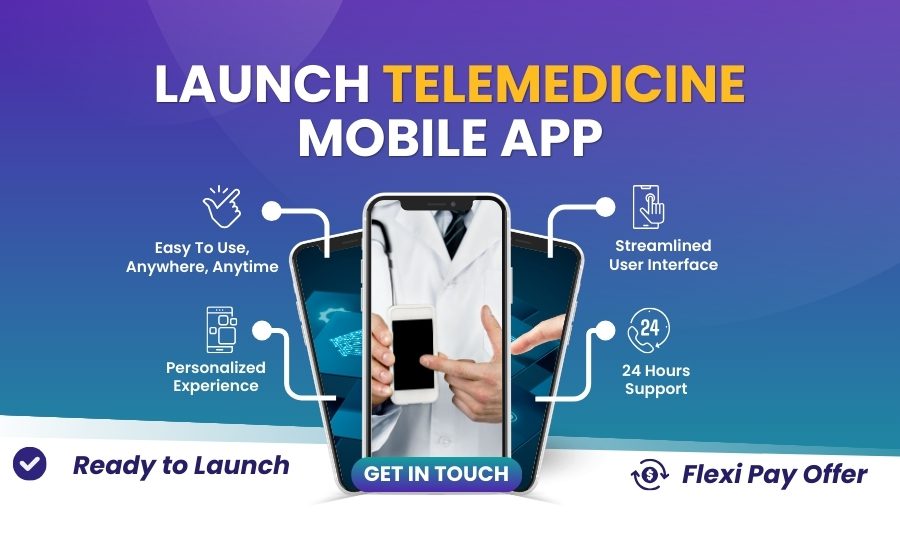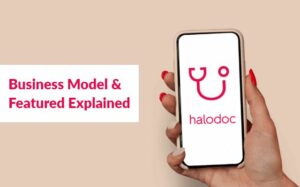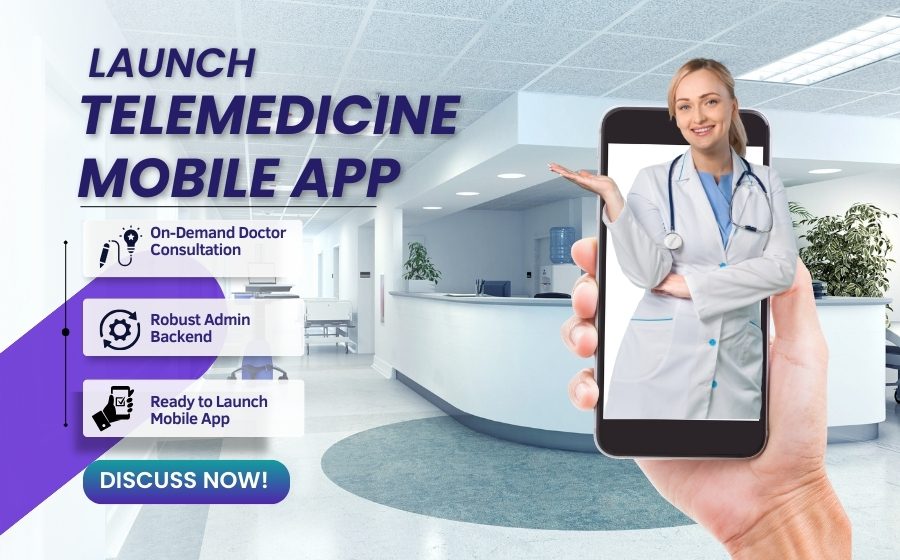The field of telemedicine is growing quickly, and usage is now far higher than before the pandemic. In response, healthcare providers are using white-label telemedicine software for a quick and easy transition into virtual treatment.
These ready-to-use platforms, which include capabilities like text messaging, video consultations, and electronic prescriptions, can be personalized with a provider’s branding. Creating white-label telemedicine apps is a quick fix for the pressing need for effective and easily accessible virtual healthcare services.
To develop a white-label telemedicine app that attracts patients and stands out in the competitive digital healthcare industry, we’ll examine the essential steps, features, necessary financial commitment, and telemedicine platform development, as this blog will demonstrate.
What is a White-Label Telemedicine App
A White-Label Telemedicine App is an already-developed software solution for healthcare services that companies may rebrand and customize to meet their requirements.
This approach avoids the drawn-out and resource-intensive process of creating an app from scratch and enables the quick deployment of telemedicine services under a business’s own brand.
In today’s healthcare environment; the value of white-label telemedicine apps and telemedicine platform development cannot be emphasized.
According to a Grand View Research analysis; the worldwide telemedicine industry is expected to reach $169.45 billion in 2024; making the need for affordable and effective healthcare solutions even more urgent.
This increase is partially due to the growing demand for remote patient monitoring and care coordination; especially after the COVID-19 pandemic.
In addition to saving time and money on development; white-label solutions free up healthcare providers to concentrate on providing high-quality treatment rather than being bogged down by the intricacies of app development.
White-label Telemedicine Apps’ Main Benefits
Companies in the healthcare industry should invest in a white-label telemedicine platform, as it may offer significant advantages.
Increased Usability
Healthcare providers may access a larger patient population using white-label telemedicine technologies, eliminating regional limitations.
Patients who live in rural or underserved locations would benefit from this enhanced accessibility, which also creates new commercial prospects.
Lessening of Technical Stress
By choosing a white-label solution, you may avoid requiring extensive technical knowledge. Utilizing an existing app’s strong infrastructure, which has previously undergone performance and reliability testing, allows businesses to concentrate less on technological issues and more on patient care.
Cost-effectiveness
It might be expensive to create a telemedicine app from the ground up. Telehealth software development is an affordable substitute for bespoke development, which offers a high-quality platform without the heavy cost.
Its economical nature makes it a compelling choice, particularly for small and medium-sized enterprises.
Added Practicality
White-label telemedicine app development is the most convenient option for consumers and healthcare practitioners.
Patients benefit from simple access to healthcare services, while providers gain from expedited processes like patient management and appointment scheduling combined into an intuitive user interface.
The advantage over competitors
Offering telemedicine services as soon as possible might give you a big competitive edge in a rapidly changing market for digital healthcare. By allowing companies to join the market quickly, white-label platform development helps them remain ahead of rivals in the early stages of development.
Reliability
Companies’ demands evolve as they expand. Scalability is a key architectural feature of white-label telemedicine platforms, making it simple to develop and modify. These platforms may change as your company does through new feature additions, user capacity increases, or market expansion.
Cost of Building a White-Label Telemedicine App
The Telemedicine app development cost depends on several variables. The range for developing a telemedicine app is between $40,000 and $300,000.
The app’s overall complexity is the primary component determining the total development cost. For example, the price of simple telemedicine software that only allows for appointment booking will be far lower than that of a complicated or Customizable telemedicine solutions app that includes video conversations and artificial intelligence diagnoses.
In addition, developers who specialize in healthcare may provide more expensive quotes. Their expertise may, however, result in a more refined and conforming product.
The initial app development cost alone cannot determine the bespoke white-label telemedicine app development cost. Funds must also be set aside for regular server maintenance, upgrades, and support.
The inclusion of outside services could increase the cost. The ROI potential of each supplementary feature should be assessed. Successful applications combine affordability, practicality, and design that focus on the user. The final product should be an app useful for doctors and their patients.
Essential Features of a White-Label Telemedicine App
What steps can one take to construct a telemedicine platform? To build software for telemedicine, you need to make a feature list and choose certain tools.
There has to be a way for doctors and patients to communicate in any telemedicine app. Depending on their functions, their feature sets will change.
Video Conferencing
Essential to the development of telemedicine applications. For the doctor to notice any probable injuries or symptoms, the video has to be provided in the highest quality possible. In addition, the sound ought to be audible and strong.
Your program needs to adjust the video quality automatically to prevent buffering, as every user has a unique internet connection. But you need to make the most of your real-time connection. One great example of telemedicine technology for creating video chat is streaming protocols like RTMP and WebRTC.
Examining EHRs
Medical professionals, not patients, should have access to electronic health records. Verify that your database does not allow clinicians to download electronic health records. If the phone with this crucial information is misplaced, you will face consequences.
Registration
The opportunity to sign in is front and center. Users must have their account to access sensitive information, such as electronic health records (EHRs), stored in telemedicine apps. In addition, managing appointment calendars inside the app is more convenient than trying to recall them.
Users can access their accounts using email addresses or third-party solutions like Google Sign-In or Facebook Login. Alternatively, employ two-factor authentication by email or SMS to safeguard personal accounts.
Message Security
Customers have the option to text doctors when video conversations are unnecessary. One possibility for handling minor issues is sending a text message, as this does not need a separate consultation.
Unlike text messages, which may be replied to whenever the doctor has a moment, video conversations can take the focus off other patients. One great feature of texting is the ability to attach files and photos.
Regarding technologies, Twilio is a platform that allows users to create live conversations for apps. Twilio is now an appropriate platform for developing telemedicine apps as it is HIPAA-compliant.
Payment Information
This is an essential step in the creation of any telemedicine application. You can choose to use a third-party system or a bespoke payment source.
Either way, remember security. Before using third-party services, you must do your homework and choose a reliable supplier. Follow all current security and data standards while creating your payment system.
Third-party solutions can usually meet all company needs. However, if you wish to create a unique payment mechanism, you must work with a capable telemedicine app development business.
Patient Portals
After registering, the user needs to create a profile. This profile includes basic personal data like name, age, and gender. The most important piece of data in a profile is the user’s EHR. Medical professionals may use it to assess patients’ medical issues and review their prior treatment records.
Remember that only the owner and doctors should access this private information. Take caution since HIPAA regulations prevent unauthorized third parties from accessing EHRs, ensuring a HIPAA-compliant telehealth app.
Challenges and Considerations
Despite the potential benefits, it is critical to understand the healthcare technology ecosystem before designing white-label telemedicine software.
Regulatory Compliance:
Maintain patient confidentiality and data security according to many healthcare standards.
Any changes to telemedicine legislation might affect your app, so it’s important to stay updated.
Integration with Existing Systems:
Ensure all current healthcare systems, including EHRs and billing systems, communicate smoothly.
The software must be compatible with other healthcare applications to provide comprehensive patient care.
User Adoption and Trust
Put users’ security and privacy first to earn their confidence.
Give people the tools they need to learn about and use telemedicine.
Scalability
The app’s design should be scalable to handle increasing users.
Be prepared for difficulties that may arise due to a surge in the demand for telemedicine services.
Interoperability
Aim for healthcare system interoperability so data may be easily exchanged.
Make sure the app works well with all platforms and devices.
Improving the User Experience
Emphasize the importance of creating interfaces that are easy for users to navigate.
Think about the many different requirements of healthcare professionals and patients.
Future-Proofing Your Telemedicine Solution
Personalization as a Key Driver
A move toward more customized patient experiences will characterize telemedicine systems in the future. To meet the growing need for personalized healthcare solutions, white-label telemedicine systems should include tools that make it easier for patients to express their unique needs.
Healthcare quality and efficiency improvements are possible due to this trend toward personalized treatment programs and using artificial intelligence (AI) technologies for predictive health analytics.
The Use of AI to Improve Analytics
One major development that will determine the fate of telemedicine systems is the incorporation of artificial intelligence (AI). Thanks to their superior analytical and predictive powers, AI tools are about to change the face of healthcare as we know it. Better diagnostic accuracy, more efficient healthcare delivery, and individualized treatment regimens are all possible outcomes of telemedicine platforms that include AI extensively.
AR and VR for Online Medical Diagnostics
Virtual reality (VR) and augmented reality (AR) in remote diagnostics are two significant trends expected to emerge. With these immersive technologies, remote medical condition diagnosis and visualization are now possible.
The diagnosis process is improved when AR and VR capabilities are integrated into telemedicine systems, giving medical practitioners more thorough and accurate insights.
Cooperation for Smooth Data Transfer
Platforms for telemedicine are becoming increasingly interoperable. Complete care management requires seamless data transfer across various systems and devices.
Future platforms are anticipated to provide broad device connections, guaranteeing that patient data will be conveniently obtainable and movable between different healthcare systems.
5G Technology to Improve Communication
The introduction of 5G technology will greatly enhance the capabilities of telemedicine. Improved telehealth service responsiveness and efficiency directly correlate with faster and more dependable connectivity.
5G networks will be faster and more capable, enabling real-time Communication, better video consultations, and more advanced remote monitoring features.
Wrapping it Up
White-label telemedicine app development is a smart and practical option for healthcare providers. This guide describes the main features, advantages, and the crucial role mobile applications play in revolutionizing healthcare delivery. Adopting this technology is a commitment to improving patient-centered services and making healthcare accessible in the digital era, not merely a calculated move.
Join us as we embark on an exciting adventure into the world of White Label Telemedicine App Development. Here at Esferasoft Solutions, we’re experts in telemedicine and cutting-edge generative artificial intelligence solutions. Beyond technology, we are devoted to customizing solutions that help you navigate the complexities of developing a strong telemedicine platform. Our skilled staff works hard to create smart, user-focused applications that guarantee your business takes the lead in the ever-changing telemedicine market.
Are you eager to learn more about developing White-Label Telemedicine Apps? Go to the “Contact Us” section below to arrange a free consultation and start your trip right now.













